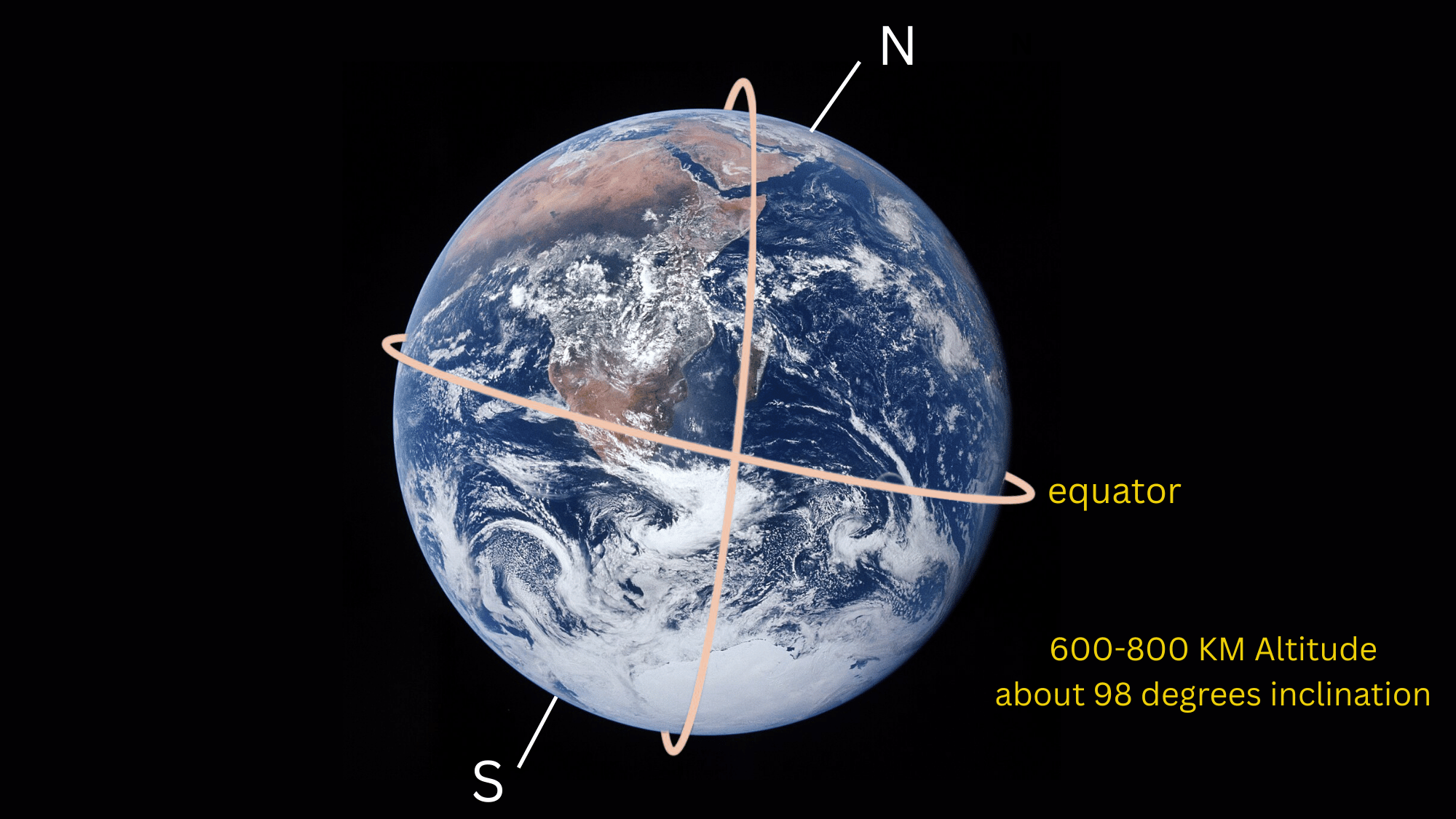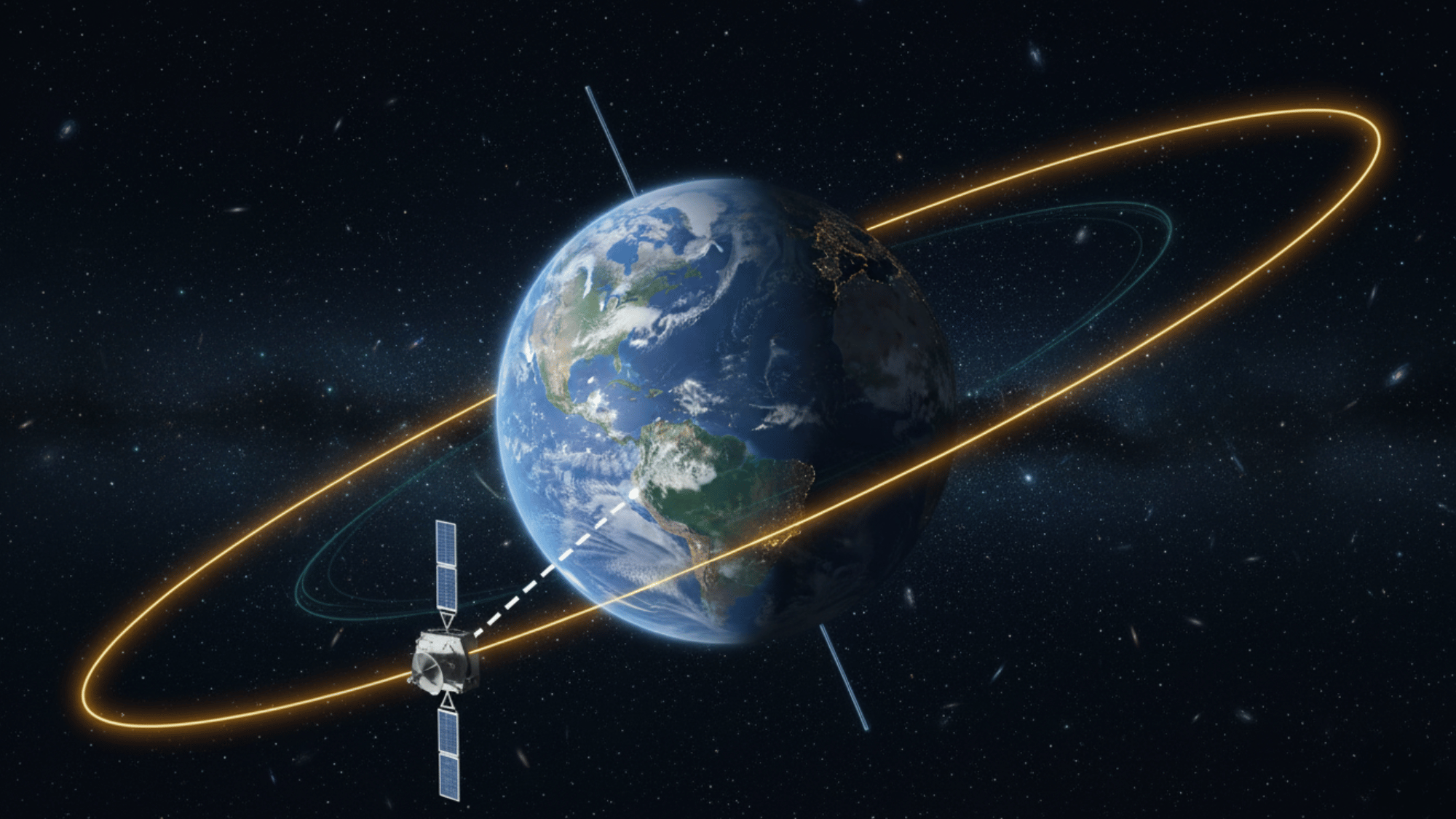Imagine looking up at the sky and knowing that a satellite is passing over the same place at the same time every single day.
These satellites play a huge role in how we study Earth, predict weather, and watch changes in our environment. From tracking forest growth to spotting storms before they strike, they help scientists understand our planet in ways we never could from the ground.
But how do they manage to keep such a perfect schedule with the Sun?
The secret lies in a special kind of orbit called a sun-synchronous orbit. Let’s learn what it is, how it works, and why it’s so important.
What is a Sun Synchronous Orbit?
A sun-synchronous orbit is a near-polar orbit where a satellite passes over the same regions of Earth at the same local solar time each day.
In simpler words, the Sun is always in the same position in the sky each time the satellite flies over.
This creates consistent lighting conditions, which makes it easier to compare photos, track changes, and measure patterns on Earth over time.
By carefully tilting its path, the satellite stays in step with Earth’s movement around the Sun, giving scientists a reliable and repeatable view of the planet.
Key Characteristics of a Sun Synchronous Orbit

This orbit has some very special features that make it useful for science and mapping. These features control how high the satellite flies, how it tilts, and how it stays in step with the Sun.
Altitude
Satellites in this orbit usually fly between 600 and 800 kilometers above Earth. At this height, they are far enough away to cover large areas but still close enough to capture sharp images.
This balance helps scientists to monitor forests, farms, oceans, and even cities.
If the satellites flew much higher, the detail would be lost. If they were lower, they could not cover as much ground.
Tilt
The orbit is tilted at about 98 degrees, which makes the satellite travel near the North and South Poles.
This tilt is important because it lets the satellite sweep across nearly the entire planet as Earth rotates beneath it. Instead of circling only around the equator, the satellite moves in a path that connects pole to pole.
This design gives scientists a global view, not just a narrow strip.
Timing
One of the most important parts of this orbit is timing.
The satellite crosses each place on Earth at the same time of day; for example, it might always pass over New York City at 10 a.m.
This steady timing means that sunlight angles and shadows stay nearly identical.
When scientists compare images from different days, they know lighting conditions are consistent, which makes tracking changes much easier.
Stability
Earth is not a perfect sphere; it’s slightly wider at the equator.
This bulge helps the orbit shift slowly in a way that matches Earth’s movement around the Sun. That slow, steady shift, called precession, keeps the satellite lined up with sunlight all year long.
Thanks to this natural balance, the orbit stays in sync with daylight for many years without losing its rhythm.
How Does Sun Synchronous Orbit Work?
A sun-synchronous orbit is special because it lets satellites pass over the same areas of Earth at the same local solar time every day. This gives scientists consistent lighting for accurate images and data. This is how it works:
- The Earth spins once every 24 hours, giving us day and night.
- The Earth also orbits the Sun once every year.
- The satellite in a sun-synchronous orbit circles Earth roughly every 100 minutes, traveling from pole to pole.
- As Earth rotates beneath it, the satellite covers new areas with each pass.
The trick lies in matching the orbit’s slow rotation (caused by Earth’s bulge) with the planet’s yearly motion around the Sun.
This alignment ensures that, even though the Earth is moving through space, the satellite’s orbit shifts just enough to keep the Sun at the same position for each pass.
In short:
The satellite moves fast around Earth, Earth moves around the Sun, and both motions work together so that sunlight always hits the satellite’s path in the same way.
It’s like setting a clock that resets itself every day; no matter how Earth moves, the timing stays locked.
Why are Sun-Synchronous Orbits Useful?
Sun-synchronous orbits are incredibly valuable for Earth observation. They give scientists steady, repeatable views of the same locations in identical light conditions.
These orbits are used for a wide range of Earth observation purposes, including:
- Weather forecasting
- Climate and environmental monitoring
- Mapping and land use planning
- Disaster tracking, such as floods, droughts, and wildfires
Because the lighting conditions stay constant, scientists can easily track gradual changes on Earth’s surface, whether it’s a growing city, a shrinking glacier, or a shifting coastline.
It’s not just space agencies that benefit from these orbits. Governments, universities, and private companies all rely on sun-synchronous satellites for decision-making and research that impact daily life.
For example:
- NASA’s Landsat satellites have been observing Earth since the 1970s, helping track deforestation, urban growth, and melting ice caps.
- ESA’s Sentinel satellites, part of Europe’s Copernicus program, monitor sea levels, air quality, and vegetation changes around the world.
- Farmers use satellite data to track soil moisture and crop health.
- Environmental groups monitor forest loss and ecosystem recovery.
- Meteorologists study global weather systems to improve forecasts and predict extreme events.
Together, these satellites form a global network that helps us understand, protect, and plan for the future of our planet, all thanks to the precise timing and steady sunlight of sun-synchronous orbits
Pros and Cons of Sun Synchronous Orbits
Like any orbit, a sun-synchronous orbit has strengths and limitations. Knowing both helps explain why it is perfect for some missions but not suited for others.
| Pros | Cons |
|---|---|
| Provides consistent lighting for images | Not ideal for continuous communication satellites |
| Perfect for long-term studies and comparisons | Limited coverage for navigation systems like GPS |
| Covers almost the entire Earth over time | Requires careful design to maintain stability |
| Useful for weather forecasting, mapping, and climate tracking | Slower revisit times than some lower orbits |
| Supports disaster monitoring with reliable data | Cannot hover over one location like geostationary satellites |
Conclusion
The idea behind a sun-synchronous orbit is simple yet powerful: timing.
By keeping satellites in sync with the Sun, these orbits create a steady rhythm that helps humanity study Earth with unmatched accuracy.
They’ve become one of the most reliable tools for understanding our world, from tracking melting ice caps to planning disaster responses.
What makes them truly remarkable isn’t just the technology, but how they connect space science to human life, helping us prepare for storms, protect forests, and plan for a sustainable future.
Sun-synchronous orbits remind us that sometimes, the smartest designs don’t fight nature; they flow with it, perfectly in step with the rhythm of the Sun.


















